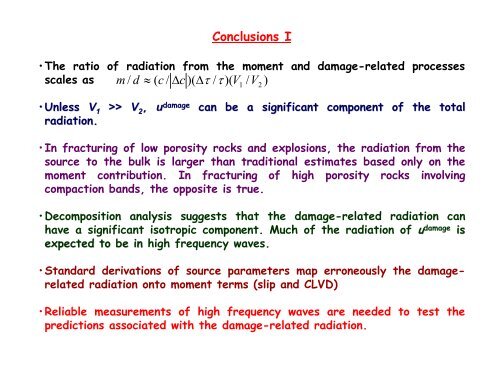Insights into earthquake source physics from high-frequency ... - IRIS
Insights into earthquake source physics from high-frequency ... - IRIS
Insights into earthquake source physics from high-frequency ... - IRIS
You also want an ePaper? Increase the reach of your titles
YUMPU automatically turns print PDFs into web optimized ePapers that Google loves.
Conclusions I<br />
• The ratio of radiation <strong>from</strong> the moment and damage-related processes<br />
scales as<br />
m / d 0 ( c / ) c )().<br />
/.<br />
)( V 1<br />
/ V2<br />
)<br />
• Unless V 1<br />
>> V 2<br />
, u radiation.<br />
can be a significant component of the total<br />
• In fracturing of low porosity rocks and explosions, the radiation <strong>from</strong> the<br />
<strong>source</strong> to the bulk is larger than traditional estimates based only on the<br />
moment contribution. In fracturing of <strong>high</strong> porosity rocks involving<br />
compaction bands, the opposite is true.<br />
• Decomposition analysis suggests that the damage-related radiation can<br />
have a significant isotropic component. Much of the radiation of u damage<br />
is<br />
expected to be in <strong>high</strong> <strong>frequency</strong> waves.<br />
• Standard derivations of <strong>source</strong> parameters map erroneously the damagerelated<br />
radiation onto moment terms (slip and CLVD)<br />
• Reliable measurements of <strong>high</strong> <strong>frequency</strong> waves are needed to test the<br />
predictions associated with the damage-related radiation.

















